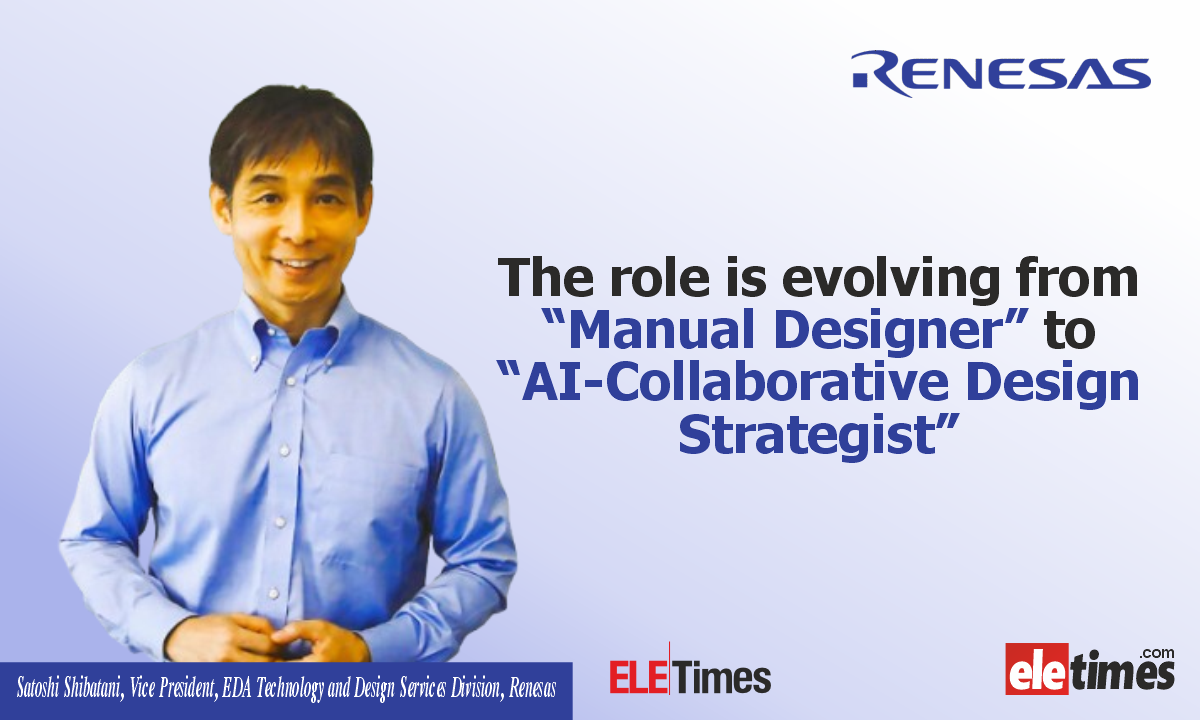“AI is redefining the role of designers by automating design engineering, improving verification accuracy, and shortening development cycles,” says Satoshi Shibatani, vice president of EDA Technology and Design Services Division at Renesas, in an exclusive conversation with ELE Times. As various professions worldwide undergo a profound shift in their thought processes and operations, largely driven by the emergence of AI, ELE Times takes the hot seat with Satoshi Shibatani of Renesas, the second most prominent company in the automotive microcontroller market in 2024, to discuss the dynamics of the changing role specifically in the landscape of product design and development.
He remarks, “The role of an engineer is evolving from ‘manual designer’ to ‘AI-collaborative design strategist,’ underlining the impact AI has made on the role of an engineer in the landscape of product development. Through this, he also reflects on the expectations that the companies have of the prospective engineers, which is to become more and more AI-friendly and intelligence-collaborative.
How’s the transformation playing out?
“At Renesas, we have been advancing design efficiency using AI through the company-wide ‘Design by AI Project’ since 2021, and it has already shown results across many development processes,” says Satoshi, reflecting on the prevalent use of AI at Renesas specifically for product design and development. This captures the early adoption approach that Renesas pursued with the AI technology to enable growth and transformation in the product development cycle.
Which part is most AI-based now?
Since design is one of the most important and complex stages of product development, it is vital to know which part has been most affected by AI. Among the various processes involved in the design cycle of a product, verification is one aspect that has been widely affected owing to the emergence of AI. “In verification, generative AI is used for RTL (Register Transfer Level) reviews and spec analysis, which is expected to enable early bug detection and a significant reduction in verification processes,” says Satoshi.
With this illustration, he simply shows how AI has influenced decision-making at the level of product design through venturing into such intricate processes as bug detection.
How exactly is Renesas using AI?
At Renesas, AI is being integrated into design through what the company describes as a “collaborative design style.” Rather than relying on AI solely for automation, designers interact with its outputs, assess the results, and propose improvements. “In this model, AI serves not merely as an automation tool but as a collaborative partner that enhances human thinking. Innovation is driven by human creativity, and rapid trial-and-error cycles help us reach our potential and foster continuous breakthroughs,” Satoshi remarks.
How’s the role of engineers changing then?
As AI takes a more central role in design, the role of engineers at Renesas is also transforming. Shibatani explains that the shift is from being a “manual designer” to becoming an “AI-collaborative design strategist.” This means engineers are now expected to go beyond traditional design skills and embrace new capabilities such as data literacy, prompt engineering, AI model interpretation, and the use of collaborative AI tools.
“We provide training programs covering AI tool usage, interactive design support with generative AI, model building, and output evaluation and improvement,” he adds, noting that Renesas is actively shaping an environment to support this talent development and ensure engineers are equipped for the future.
What’s the real efficiency metric?
While aims and efforts do count, metrics make the final case for business. “For design optimization, AI has improved design efficiency by up to 30% in some cases,” says Satoshi as he underlines the real metric conveying the impact of AI usage in the product design and development cycle at Renesas. He states that the company has been consistently enhancing design efficiency since 2021. As a result, apart from the improved productivity through automation, AI usage has contributed to better PPA (Performance, Power, Area) metrics at Renesas.
Why is it not all good yet?
In the conversation, he further touches upon the various challenges that accompany AI prevalence in the development cycle. It includes “data quality, vendor collaboration, security, and tool integration,” says Satoshi, underlining the fact that no system is devoid of challenges for the engineers. He further states that to address the very issue of data quality, Renesas has built a system that quantitatively measures AI data quality by combining existing EDA tools and technologies.
As with any system, the AI-powered processes are going through a transition phase wherein various modes and operations are yet to be witnessed. At this stage, AI is significantly improving analysis speed and accuracy by parsing large design datasets and specifications to auto-generate verification plans and test benches. However, it continues to operate under human supervision and is not fully autonomous. Sensitive customer data remains excluded from training and is discarded after use, while strict traceability measures are in place to ensure reliability and prevent hallucinations.






